Optimization of RAPD-PCR conditions for the study of genetic diversity in Nepal’s <i>Swertia chirayita</i> (Roxb. Ex Fleming) H. Karst
DOI:
https://doi.org/10.3126/hjs.v6i8.2699Keywords:
Polymerase Chain Reaction, Random Amplified Polymorphic DNA, DNA fingerprinting, genetic diversityAbstract
Of the 30 species (including five varieties) of the genus Swertia in Nepal, nine have been reported to possess medicinal properties. Among these, S. chirayita is the most valuable species, with high demand in domestic and international markets. Nepal’s S. chirayita and related species are being recklessly exploited for commercial purposes. Two problems that have emerged with this lucrative market are (a) adulteration and fraudulent labeling of S. chirayita, and (b) depletion of S. chirayita and allied species from their natural habitats. To address the problem of adulteration and conservation, we studied molecular genetic diversity in S. chirayita populations and developed a molecular diagnostic tool for the purposes of authentication. We studied intra-specific genetic diversity in S. chirayita using Polymerase Chain Reaction (PCR)-based Random Amplified Polymorphic DNA (RAPD) technique. As a preliminary step, we identified optimal RAPD-PCR reaction and cycling conditions by varying PCR reaction parameters such as concentration of template DNA, MgCl2, dNTPs, primer, Taq DNA polymerase and RAPD-PCR programs. The optimized PCR reaction and cycling conditions were then used in subsequent RAPD profiling experiments for the study of genetic diversity within S. chirayita populations from various geographical locations. Genetic diversity characterization of S. chirayita populations at the molecular level would furnish information with significant applications in the conservation and sustainable utilization of S. chirayita and its allied species in Nepal.
Key words: Polymerase Chain Reaction, Random Amplified Polymorphic DNA, DNA fingerprinting, genetic diversity
DOI: http://dx.doi.org/10.3126/hjs.v6i8.2699
Himalayan Journal of Sciences Vol.6 Issue 8 2010 pp.35-40




